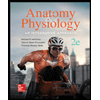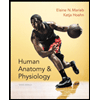
Human Anatomy & Physiology (11th Edition)
11th Edition
ISBN: 9780134580999
Author: Elaine N. Marieb, Katja N. Hoehn
Publisher: PEARSON
expand_more
expand_more
format_list_bulleted
Question
thumb_up100%
- Compare the anatomy and chemical communication of the somatic motor, parasympathetic, and sympathetic divisions.
- Explain the molecular events of the sarcomere which result in contraction
- Explain how antagonistic control is a hallmark of the autonomic nervous system.
- Compare the synthesis, storage, transport. location of receptors, and cellular mechanism of action for the four major groups of hormones: catecholamine, thyroid, peptide and steroid hormones.
- Compare the structure and function of skeletal, cardiac, and smooth muscle
- Compare nicotinic cholinergic, muscarinic cholinergic, and adrenergic receptors.
- Compare the two main types of alpha receptors and the three main types of beta receptors.
- Discuss the six anterior pituitary hormones, their primary targets and the hormones which control their release.
- Discuss the role of the Na+K+ pump in maintaining the membrane potential of a cell.
- Describe the three most common types of endocrine pathologies.
Expert Solution
This question has been solved!
Explore an expertly crafted, step-by-step solution for a thorough understanding of key concepts.
This is a popular solution
Trending nowThis is a popular solution!
Step by stepSolved in 3 steps

Knowledge Booster
Similar questions
- Which of the following statements about the relationship between the nervous and endocrine systems is NOT correct? Hypothalamus controls a part of the endocrine system called the pituitary gland. Hypothalamus produces ADH Neurons of the sympathetic nervous system stimulate the production of hormones from the adrenal gland. None of these. Which refers to the time during which a neuron can undergo an action potential? the resting membrane potential the depolarization period of the neuron polarization period of the neuron O the membrane potentialarrow_forwardB. Alkaloid caffeine contained in coffee seeds causes hyperglycemia and has a stimulatory effect, although it does not interact with epinephrine receptors. It is known that caffeine inhibits phosphodiesterase activity. Why can caffeine decrease the blood glucose level? Explain the answer and draw the appropriate schemes.arrow_forwardThe hormone mechanism which results in the release of intracellular Ca++ is the: Question options: PIP 2nd messenger mechanism humoral mechanism 2nd messenger – adenylate cyclase mechanism Steroid hormone mechanismarrow_forward
- Exercise Exercise places demands on the body. Cells require extra energy and water is lost through sweating. The breathing rate and heart rate increases during exercise to deliver more glucose and oxygen to cells which are converted to ATP through cellular respiration. Identify three hormones that are involved in re-establishing homeostasis after an intense workout and explain why they are involved.arrow_forwardFor both T1DM and T2DM, describe the following: Causes Symptoms Treatments Glucose levels Insulin levels Insulin receptor sensitivity Also please discuss the cause/effect relationship between acute and chronic stress (chronic disease or homelessness, for instance) and T1DM and T2DM. What is the mechanism by which the nervous system impacts stress hormones? Are there neurotransmitters involved? Which neurotransmitters? Which stress hormones?arrow_forwardEpinephrine and norepinephrine are chemicals that act as both neurotransmitters and hormones. Describe where they are released from, what organs they target and how they play a role in the sympathetic nervous system.arrow_forward
- Normally, when blood glucose level increases (e.g. after a meal), the islet cells in the pancreas secrete insulin. When insulin molecules bind to insulin receptors on the surface of a muscle cell, the receptors become activated, initiating a signaling pathway which eventually results in the increase in the number of passive glucose transporter on the muscle cell surface thus increases the uptake of glucose into the cell and decrease blood glucose level. Indicate whether the following conditions/practice will likely lead to diabetes (mark Yes or No). [Select] degeneration of islet cells [Select] [Select] [Select] a mutation in the insulin receptor that increases its kinase activity ✓ exercise a mutation in the insulin receptor that prevents dimerizationarrow_forwardThe hormone mechanism which results in the release of intracellular Ca++ is the: 2nd messenger – adenylate cyclase mechanism PIP 2nd messenger mechanism O humoral mechanism Steroid hormone mechanismarrow_forwardExplain the nature of a tropic hormone.arrow_forward
- During a sympathetic nervous system response to an event, your heart rate increases, indicating the part of the heart responsible for controlling heart rate (the sinoatrial node) is innervated by sympathetic nerves. The SA node is also responsive to epinephrine,a hormone secreted by the adrenal medulla. Explain why the onset of the effect of the hormone is so much slower than the onset of the effect from sympathetic nerve stimulation and yet the effect of the hormone lasts much longer than the effect of nerve stimulation.arrow_forwardCompare and contrast formulation of long acting insulin and short acting insulin. How do their properties help control the rate at which the Delivered insulin enters bloodstream?arrow_forwardFeedback loops regulate the release of hormones in either a positive or negative loop. Consider this example: The hypothalamus releases thyrotropin releasing hormone (TRH), which stimulates the pituitary to release the TSH (thyroid stimulating hormone). TSH then stimulates thyroid gland to release thyroid hormone. When elevated levels of thyroid hormone are detected by the hypothalamus and pituitary further release of TRH and TSH is suppressed. b. What would happen to the levels of TRH and TSH if a tumor of the thyroid gland were discovered resulting in uncontrolled release of the thyroid hormone from the tumor itself? * Your answer (LENGHT DOESN'T MATTER, I NEED IT ASASP PLEASE)arrow_forward
arrow_back_ios
SEE MORE QUESTIONS
arrow_forward_ios
Recommended textbooks for you
 Human Anatomy & Physiology (11th Edition)Anatomy and PhysiologyISBN:9780134580999Author:Elaine N. Marieb, Katja N. HoehnPublisher:PEARSON
Human Anatomy & Physiology (11th Edition)Anatomy and PhysiologyISBN:9780134580999Author:Elaine N. Marieb, Katja N. HoehnPublisher:PEARSON Anatomy & PhysiologyAnatomy and PhysiologyISBN:9781259398629Author:McKinley, Michael P., O'loughlin, Valerie Dean, Bidle, Theresa StouterPublisher:Mcgraw Hill Education,
Anatomy & PhysiologyAnatomy and PhysiologyISBN:9781259398629Author:McKinley, Michael P., O'loughlin, Valerie Dean, Bidle, Theresa StouterPublisher:Mcgraw Hill Education, Human AnatomyAnatomy and PhysiologyISBN:9780135168059Author:Marieb, Elaine Nicpon, Brady, Patricia, Mallatt, JonPublisher:Pearson Education, Inc.,
Human AnatomyAnatomy and PhysiologyISBN:9780135168059Author:Marieb, Elaine Nicpon, Brady, Patricia, Mallatt, JonPublisher:Pearson Education, Inc., Anatomy & Physiology: An Integrative ApproachAnatomy and PhysiologyISBN:9780078024283Author:Michael McKinley Dr., Valerie O'Loughlin, Theresa BidlePublisher:McGraw-Hill Education
Anatomy & Physiology: An Integrative ApproachAnatomy and PhysiologyISBN:9780078024283Author:Michael McKinley Dr., Valerie O'Loughlin, Theresa BidlePublisher:McGraw-Hill Education Human Anatomy & Physiology (Marieb, Human Anatomy...Anatomy and PhysiologyISBN:9780321927040Author:Elaine N. Marieb, Katja HoehnPublisher:PEARSON
Human Anatomy & Physiology (Marieb, Human Anatomy...Anatomy and PhysiologyISBN:9780321927040Author:Elaine N. Marieb, Katja HoehnPublisher:PEARSON

Human Anatomy & Physiology (11th Edition)
Anatomy and Physiology
ISBN:9780134580999
Author:Elaine N. Marieb, Katja N. Hoehn
Publisher:PEARSON

Anatomy & Physiology
Anatomy and Physiology
ISBN:9781259398629
Author:McKinley, Michael P., O'loughlin, Valerie Dean, Bidle, Theresa Stouter
Publisher:Mcgraw Hill Education,

Human Anatomy
Anatomy and Physiology
ISBN:9780135168059
Author:Marieb, Elaine Nicpon, Brady, Patricia, Mallatt, Jon
Publisher:Pearson Education, Inc.,

Anatomy & Physiology: An Integrative Approach
Anatomy and Physiology
ISBN:9780078024283
Author:Michael McKinley Dr., Valerie O'Loughlin, Theresa Bidle
Publisher:McGraw-Hill Education

Human Anatomy & Physiology (Marieb, Human Anatomy...
Anatomy and Physiology
ISBN:9780321927040
Author:Elaine N. Marieb, Katja Hoehn
Publisher:PEARSON